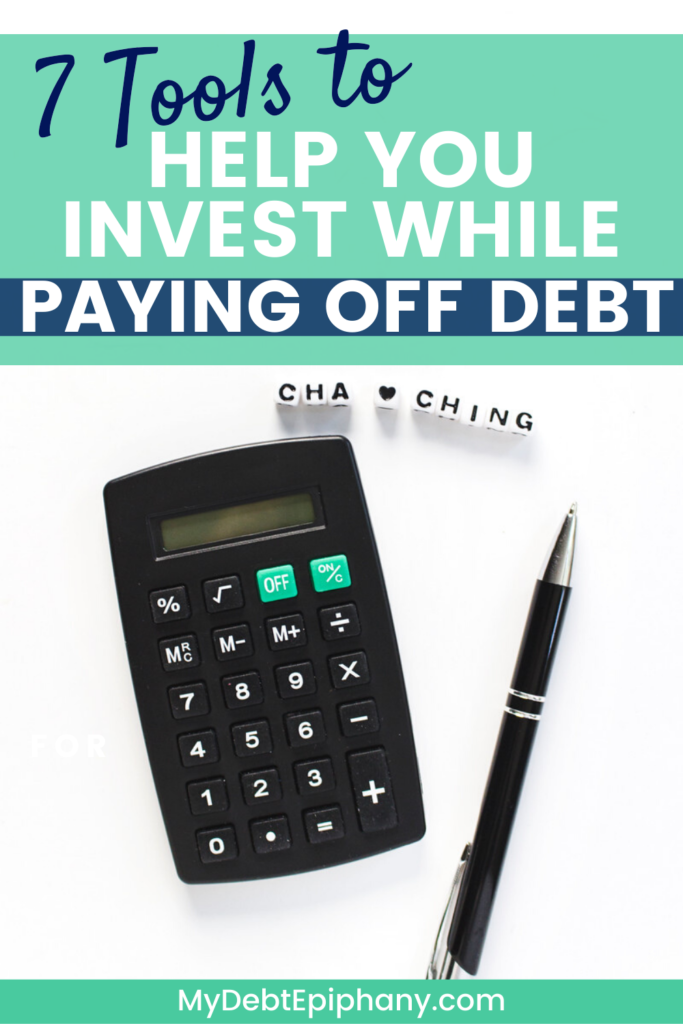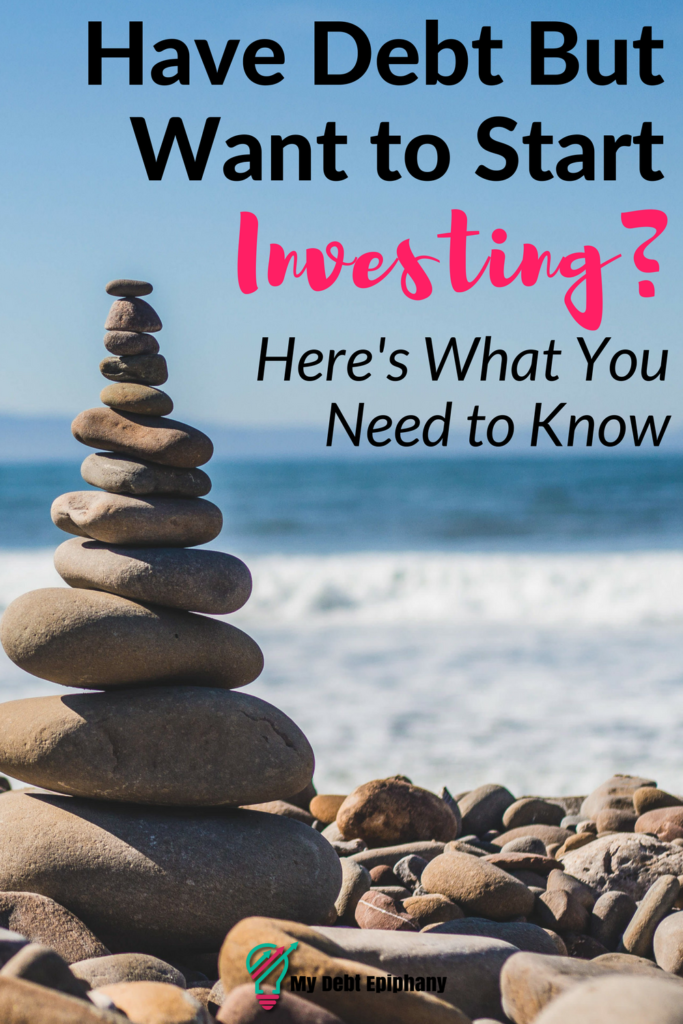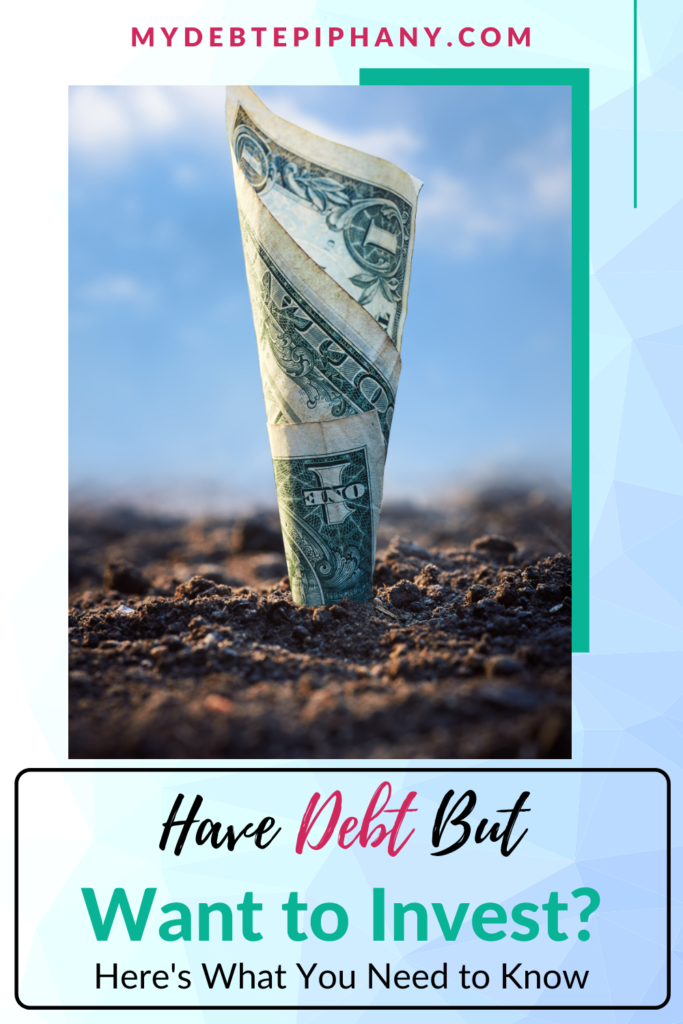Have Debt But Want to Invest? Here’s What You Need to Know
It’s no secret that debt can be a pain. It can hold you back from living the life you want to live and put a major damper on your entire financial situation. Back in 2014, I embarked on an aggressive debt payoff journey. Paying off debt does get easier over time but you have to be very motivated and focused.
One thing I’ve been slow to get started on due to my debt is investing. Investing is such an important financial move to make – early on if you can. Wondering if you should pay off debt or invest?
We all want to retire someday and build wealth. Getting started with investing is one of the best ways to do it.
Table of Contents
The Importance of Compound Interest
I used to think I could never become a millionaire but then I heard about compound interest. If you start investing at 20 years old and want to retire in your 50s, you can very well retire a millionaire thanks to interest compounding on your consistent contributions.
But enough talk about why investing is important. Today, I want to talk to you about your investing options while you are in debt. Some people advise against investing while in debt while other people prioritize it over their debt payments because there’s no better time than the present to get started.
So Should You Pay Off Debt Or Invest? Can You Do Both?
Everyone’s situation and preferences are different. What I can do, however, is provide you with the options, tools, and resources to make your own educated decision.
Paying off debt and investing are both important goals and spending your money on either could be a wise decision. What it boils down to is a few key factors like:
- Your age – If you’re in your early or mid-20s, you may want to power through debt payoff and forego investing for a few years. Even though you’ll miss out on compound interest, if you’re looking forward to a long career, you can always catch up with your investments over time.
- How much debt you have – There’s a big difference between having $10,000 or debt and $100,000 of debt. If you have a smaller debt amount, you may be able to knock it out in a few months so you can focus solely on investing. If your debt repayment journey will likely take a few years, you may want to incorporate investing so you don’t miss out on precious time.
- The type of debt you have – Do you have high-interest debt that needs to go ASAP? Or do you have low-interest debt and want to take advantage of earning a higher rate of return on your investments.
Remember, you can always do both. If you don’t want to miss out on either opportunity, consider investing and paying off debt at the same time. Sure, it may take you longer to pay off your debt, but you’ll also be growing some of your money at the same time.
The choice is really up to you, but you should start investing sooner or later. That said, here are some options for easy investing even if you still have debt.
Your 401(k)
Contributing to your 401(k) is one of the easiest ways to invest. A 401(k) is an employer-sponsored retirement plan that might be a part of your benefits package. The great thing about a 401(k) is that it allows you to contribute funds as taxes are taken out of your check, so you never really see the money leave your account to begin with.
Most 401(k) plans allow contributions to be made pre-tax meaning you’ll have to pay taxes on the money when you withdraw it. What I love about 401(k) plans is that some employers will match your contributions so it’s basically like getting free money. As an example, if you contribute up to 3 percent of your income to your 401(k), your company would match your contribution by adding 3 percent of their own so you’ll have 6 percent of your income saved up for retirement.
I’ve personally never had the privilege of being offered a 401(k) plan through my employer but my husband has and I was sure to have him check to see if his company provided a match. When we found out they did, it was a no brainier that he would contribute to his 401(k) despite having student loans and other debt.
Contribution limits change every year currently, you can contribute up to $19,500 annually if you are under 50 and an additional $6,500 catch-up contribution if you are over 50.
If you end up switching jobs, don’t forget to roll over your 401(k) contributions. DON’T attempt to withdraw the money.
Individual Retirement Funds
For people who don’t have a 401(k) plan as an option but still want to invest, an individual retirement account like a traditional IRA or Roth IRA is the next best thing. Your contributions get taxed differently with an IRA vs. a Roth IRA . With a traditional IRA, contributions are taxed when you withdraw the money and with a Roth IRA, contributions are taxed before when you deposit them into your account so when it’s time to withdraw the money, you don’t have to pay any taxes.
Since tax rates have been known to inflate over the years, it may sound better to pay your taxes upfront so you don’t have to worry about higher taxes when you retire. With a traditional IRA, you have to start making at least the minimum distributions by age 70 1/2 but with a Roth IRA, the money can continue to grow tax-free in your account throughout your lifetime.
In 2016, traditional IRA and Roth IRA annual contributions limits are $6,000 or $7,000 if you are over the age of 50. While there are no income limits for contributing to a traditional IRA, there are for a Roth IRA and you can find those here.
What I like about IRAs is that you get 15 months to make contributions that count for the calendar year instead of 12 so I will definitely start maxing out my Roth IRA next year. Another thing I like about both of these options is that after 5 years of making contributions, you can withdraw up to $10,000 penalty-free to cover first-time homebuyer expenses.
SEP IRA
The SEP IRA gets its own category because it is a type of traditional IRA for self-employed individuals or business owners. Since I’m a full-time freelancer now, this type of plan has piqued my interest.
With a SEP IRA, contributions are tax-deductible and taxed upon withdrawal just like with a traditional IRA. You can contribute up to $57,000 annually or 25% of your income to a SEP IRA (whichever is less). Unlike a Roth IRA, there isn’t a strict cap as to how much you can earn in order to contribute.

Pay Off Debt or Invest? – Other Investing Options
Let’s say you want to explore your other investing options but you don’t have a lot of money to start with. If you’re wondering whether you should pay off debt or invest, it’s understandable that most of your disposable income is going toward your debt each month.
However, if you have really low-interest debt, and can spare $100+ per month, you can start building your nest egg immediately.
Mutual Funds- Mutual funds are made up of a pool of funds collected from many different investors. Money managers operate the funds and invest them in an attempt to produce capital gains and income for the group of investors. Charles Schwab offers dozens of different mutual funds all requiring a minimum investment of around $100 once you open an account. Fidelity Investments mutual funds are also around the same price.
My Favorite Investing Apps and Programs
Betterment- Betterment is my favorite because they do all the heavy lifting for you. When you sign up for an account, you’ll fill out a brief survey about your investing goals and set up recurring deposits from a checking or savings account of at least $100 per month. Betterment then distributes your funds into ETFs based on your portfolio allocation whether it’s stocks, bonds, or both. You can even open a Roth IRA with Betterment which was perfect for me because my current employer doesn’t offer any retirement benefits.
If you choose to sign up for Betterment and start investing, be sure to use my referral link which will give you 6 months free. Normally, Betterment takes a 0.25% fee annually which is small, but with my link, you’ll be able to allow your investments to grow more with half of your first year fee-free.
Acorns – Acorns is another one of my favorite money-saving apps because it’s easy to use and helps you invest your spare change. Acorns connects to your checking account and will round up your purchases to the nearest dollar then invest the difference.
For example, if you spend $4.50 at Starbucks on a latte, Acorns will take $0.50 from your checking account and invest it. Elect that Acorns transfer 2x or 3x the amount that gets rounded up to the nearest dollar to grow your balance faster. You can also set up weekly deposits starting at just $500 per week. Acorns will invest your money in a variety of stocks, bonds, and mutual funds. Fees start at just $1 per month to use Acorns.
Sign up for Acorns using my referral link and you’ll get $5 to invest to get started.
Digit – Digit is an amazing robo-financial assistant app that helps you you grow your money and reach for your lifestyle goals. It provides a truly personalized and automated savings plan that is designed around your specific spending habits, which it uncovers through using a sophisticated algorithm. I really love how it creates one stop for all of your financial goals from paying off debt to saving for different reasons to investing.
Get started with your free Digit trial here.
Love Your Budget Course – The Love Your Budget Course was created by me to help anyone who is ready to get serious about their financial goals and make sure to account for all of them. When it comes to paying off debt or investing, as I mentioned earlier, you can do both but knowing where all your money is going is crucial to make both goals happen. This course will help you get familar with your numbers and help you feel confident in designing a budget that meets all your needs while removing stress from the equation.
Enroll in the Love Your Budget Course here.
Trade and Travel Program – The Trade and Travel Program is your entry into the world of investing in stocks. With online classes, coaching calls and bonuses you learn the complete ins and outs of the world of stocks. Your confidence will grow in learning how to pick good companies to invest in and make your first trade, protect your portfolio from losses, price your trades correctly and read stock chart as well as regulate your stock trading efforts so you’re not just having one-time surprises but frequent regular income through stock trading.
Learn more about how the Trade and Travel Program can help you build your stock investing portfolio.
Book Suggestion
If you want to learn more about investing in general, I’d highly recommend reading The Simple Path to Wealth. This is one of my favorite personal finance books and it’s worth reading over and over again.
The author, JL Collins, retired early and shares his passive strategy for getting rid of debt, having a cash cushion and investing for long-term results. This book is so easy to understand and I love how the information and ideas are clearly laid out so you can start executing them right away. It’s definitely worth the read!
Getting Started Is Easier Than You Think
It’s not difficult to get started with investing whether you have debt or not. You don’t have to start out by maxing out your retirement accounts if you can’t afford it right now but if you can contribute around $100 per month or contribute up to your 401(k) match, you’ll be off to a great start and won’t miss out on these precious years for investing that you’ll never get back.



Stop Worrying About Money and Regain Control

Join 5,000+ others to get access to free printables to help you manage your monthly bills, reduce expenses, pay off debt, and more. Receive just two emails per month with exclusive content to help you on your journey.






